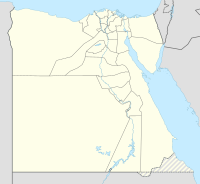Tell el-Yahudiya
Map of Egypt |
Tell el-Yahudiya ( hill of the Jews ; Greek Λεόντων πόλις Leontopolis ) is an ancient city in the eastern Nile Delta 20 kilometers northeast of Cairo and three kilometers south of Tell Basta .
Excavation history
1886-1887 Edouard Naville and 1905-1906 William Matthew Flinders Petrie carried out excavations in Tell el-Yahudiya. Shehata Adam also excavated this archaeological site in the 1950s.
Flinders Petrie described a type of ceramic found here for the first time as a Tell el-Yahudiah ware . It is made of dark gray clay and decorated with geometric patterns of notched points and lines.
Settlement in Pharaonic times
The place has been continuously populated from the Second Intermediate Period to Roman times. W. M. Flinders Petrie dug a 515 × 490 meter enclosing wall , which probably goes back to the Middle Kingdom or the Second Intermediate Period. The wall was 60 meters thick and at least 11 meters high. The interior was filled with sand ( high sand ) and probably represented an ancient hill on which a sanctuary stood. Colossal statues of Ramses II were discovered in the northeastern part of the enclosure, suggesting a temple that he had rebuilt there. Ramses III. had a palace or temple built west of the wall, in the ruins of which thousands of faience tiles were found.
The Jewish Temple of Onias
“(426) These words met with the approval of Ptolemy, and he gave him [the Onias] a slice of land 180 stadia away from Memphis, in the so-called circle of Heliopolis. (427) Here Onias first built a solid castle and then set about building the temple, which incidentally was not supposed to have any resemblance to the one in Jerusalem, but was given the shape of a tower and towered with its huge ashlar to a height of 60 cubits . (428) In the construction of the altar of burnt offerings, on the other hand, he completely took the one at home as a model, just as he made the showpieces in the temple in very similar forms. Only the work on the candlestick made an exception, (429) in that Onias did not use a candlestick frame here, but only made a golden lamp, from which the light shone directly, and let it float on a golden chain. The whole temple area was surrounded by a wall made of fired bricks, but the gates were stone buildings. "
Under Ptolemy VI. established the Jewish high priest Onias IV. , who had fled from Jerusalem before Antiochus IV. , around 170 BC. A temple northeast of the surrounding wall. According to Flavius Josephus , he had a castle-like temple built from large stone blocks, surrounded by a brick wall with stone gates. Instead of a candlestick, he hung a golden lamp. The construction of a second temple of YHWH outside of Jerusalem was legitimized by a prophecy in the biblical book Isaiah , in which an altar of the YHWH in Egypt is foretold. Most Jews - including those in Egypt - rejected this sanctuary, but it was tolerated as a sanctuary next to the Jerusalem temple . The temple was closed in 71 AD under Vespasian by the then praefectus aegypti , Tiberius Iulius Lupus , after a revolt of the Jews in Alexandria .
It has not been archaeologically proven, but the presence of Jews at this place is documented.
literature
- Manfred Bietak : Tell el-Yahudiya . In: Kathryn A. Bard (Ed.): Encyclopedia of the Archeology of Ancient Egypt . Routledge, London / New York 1999, ISBN 0-415-18589-0 , pp. 791-792.
- Hans Bonnet: Leontopolis (2nd). In: Lexicon of Egyptian Religious History . Nikol, Hamburg 2000, ISBN 3-937872-08-6 , p. 423.
- John S. Holladay Jr .: Yahudiyya, Tell el-. In: DB Redford (Ed.): The Oxford Encyclopedia of Ancient Egypt. Volume III: P - Z. Oxford University Press, Oxford 2001, ISBN 0-19-513823-6 , pp. 527-529.
- Edouard Naville : The mound of the Jew and the city of Onias. Belbeis, Samanood, Abusir, Tukh el Karmus. 1887 (= Memoirs of the Egypt Exploration Fund. Volume 7, ISSN 0307-5109 ). Paul, Trench, Trübner, London 1890 ( online ).
- WM Flinders Petrie , J. Garrow Duncan: Hyksos and Israelite Cities . Quaritch, London 1906.
- A.-P. Zivie: Tell el-Jahudija. In: Wolfgang Helck , Eberhard Otto , Wolfhart Westendorf : Lexicon of Egyptology . Volume VI: Stele - Cypress. , Harrassowitz, Wiesbaden 1986, ISBN 3-447-02663-4 , pp. 331-335.
- Max Küchler : Leontopolis . In: Religion Past and Present (RGG). 4th edition. Volume 5, Mohr-Siebeck, Tübingen 2002, Sp. 274.
Individual evidence
- ^ Translation by Philipp Kohout; The Jewish War ( Wikisource )
- ↑ Flavius Josephus, Bellum iudaicum , 1, 1, 1; 7, 10, 2
- ↑ Flavius Josephus, Bellum iudaicum , 7, 10, 3
- ↑ Isaiah 19: 18-19 EU
- ↑ Flavius Josephus, Bellum iudaicum , 7, 10, 1-2, 4
Coordinates: 30 ° 17 ' N , 31 ° 20' E

